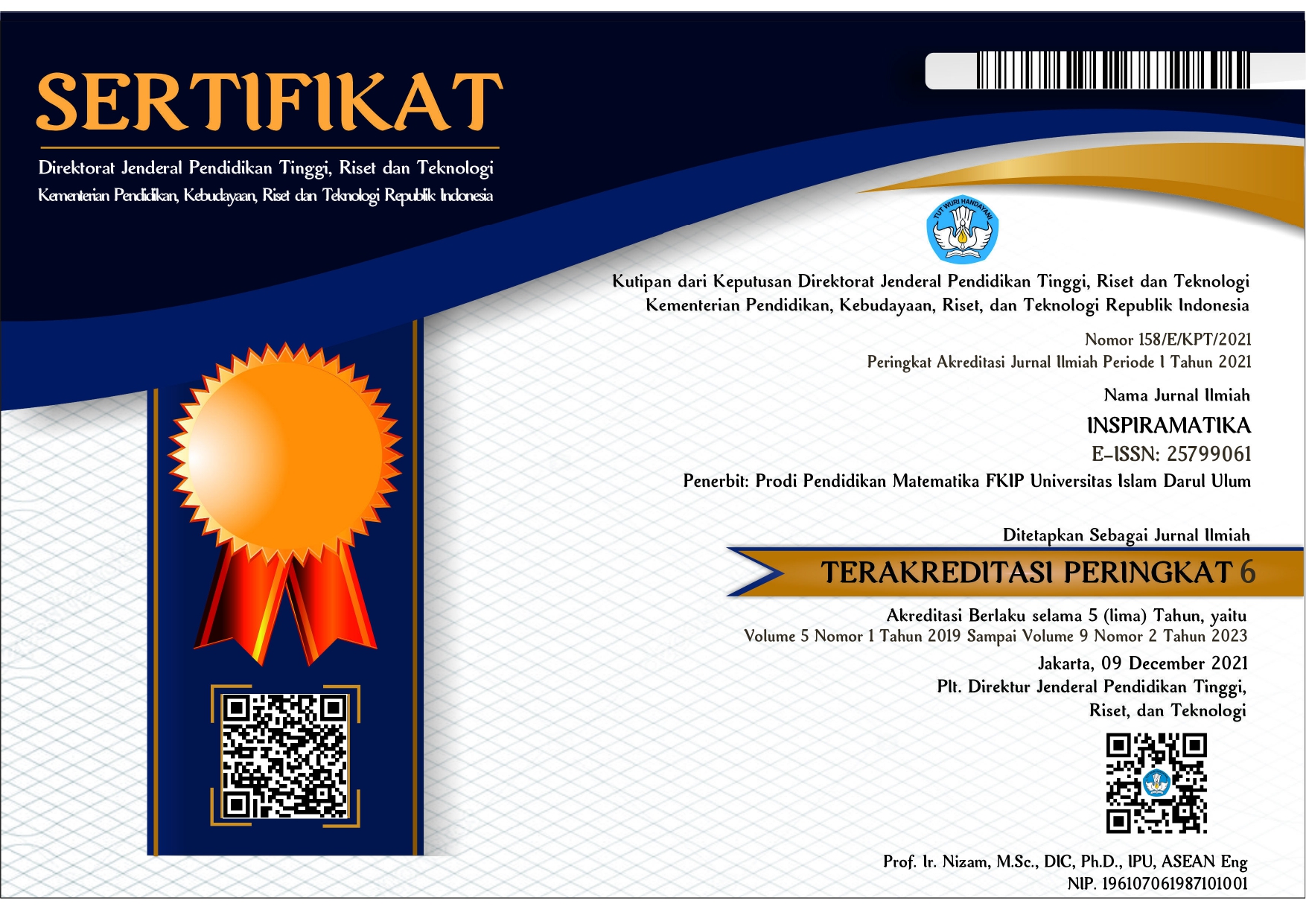ANALISIS KEMAMPUAN PEMECAHAN MASALAH MATEMATIS SISWA PADA MATERI SEGITIGA DITINJAU DARI SELF-DIRECTED LEARNING
Abstract
This study aims to describe the mathematical problem solving of class VII MTs students on triangle material in terms of high, medium, and low self-directed learning levels. This research is a qualitative descriptive study. The subjects of this study consisted of 9 students of class VII-A MTs Putra-Putri Simo for the academic year 2020/2021. Determining the subject based on the results of the questionnaire test is SRSSDL (Self-Rating Scale of Self-Directed Learning). The instruments used in this study were the SRSSDL questionnaire, mathematical problem solving ability tests, and interviews. The data used are test results and interview recordings. Analysis of the data that has been carried out the results of this study indicate that: (1) students who have the ability to solve mathematical problems with independent learning levels have been able to overcome the four problem solving indicators according to Polya, namely understanding the problem, planning problem strategies, carrying out calculations, and re-examining. problem solving results. (2) students who have the ability to solve mathematical problems with moderate independent learning levels show that they have been able to fulfill indicators 1 and 3 of problem solving according to Polya, namely understanding problems and carrying out calculations. (3) students who have the ability to solve mathematical problems with low-level independent learning are not able to meet indicators 1, 2, 3, and 4 according to Polya.
Downloads
References
Amaliah, F., Sutirna, & Zulkarnaen, R. (2021). Analisis Kemampuan Pemecahan Masalah Matematis Siswa Pada Materi Segiempat dan Segitiga. Aksioma: Jurnal Matematika dan Pendidikan Matematika, 12(1), 10-20.
BSNP. (2006). Standar Isi untuk Satuan Pendidikan Dasar dan Menengah, Standar Kompetensi dan Kompetensi Dasar SMP/MTS. Jakarta.
Hidayati, D. W. (2017). Penerapan Problem Based Learning Berbasis Self-Directed Learning Oriented Assesment terhadap Kemampuan Pemecahan Masalah. Journal of Medives: Journal of Mathematics Education IKIP Veteran Semarang, 1(1), 17-24.
Intaros, P., Inprasitha, M., dan Srisawadi, N. (2014). Student’s Problem Solving Strategies in Problem Solving-Mathematics Classroom. Procedia-Social and Behavioral Sciences, 116, 4119-4123.
Kouvela, E., Hernandez-Martinez, P., & Croft, T. (2017). This is what you need to be learning: an analysis of messages received by first-year mathematics students during their transition to university. Mathematics Education Research Journal, 30(2), 165-183.
Novilita, H. & Suharnan. (2013). Konsep Diri Adversity Quotient dan Kemandirian Belajar Siswa”, Jurnal Psikologi, 8(1), 619-632.
Pehkonen, E. (1997). The state-of-art in mathematical creativity. ZDM: Mathematics Education, 29(3), 63-67.
Permendikbud. (2018). Peraturan Menteri Pendidikan dan Kebudayaan Republik Indonesia. Nomor 36 Tahun 2018.
Putra, D. M. & Rakhmawati, L. (2015). Pengembangan Perangkat Pembelajaran Menerapkan Model Self-Directed Learning (SDL) Berbantuan Software Proteus untuk Mencapai Kompetensi Belajar Siswa. Jurnal Pendidikan Teknik Elektro, 4(1), 277-283.
Rahmatiya, R. & Miatun, A. (2020). Analisis Kemampuan Pemecahan Masalah Matematis Ditinjau dari Resiliensi Matematis Siswa SMP. Teorema: Teori dan Riset Matematika, 5(2), 187-202.
Setyawati, R. D. (2013). Pengembangan Perangkat Pembelajaran Matematika Model Problem Based Learning Berorientasi Enterpreneur dan Berbantuan CD Interaktif. Prosiding Seminar Nasional Matematika 2013. Semarang: 26 Oktober.
Sundayana, R. (2016). Kaitan antara Gaya Belajar, Kemandirian Belajar, dan Kemampuan Pemecahan Masalah Siswa SMP dalam Pelajaran Matematika. Mosharafa: Jurnal Pendidikan Matematika, 5(20), 75-84.
Suryani, M., Jufri, L. H., & Putri, T. A. (2020). Analisis Kemampuan Pemecahan Masalah Siswa Berdasarkan Kemampuan Awal Matematika. Mosharafa: Jurnal Pendidikan Matematika, 9(1), 119-130.
Tasaik, H. L. & Tuasikal, P. (2018). Peran Guru dalam Meningkatkan Kemandirian Belajar Peserta Didik Kelas V SD Inpres Samberpasi. Metodik Didaktik: Jurnal Pendidikan ke-SD-an, 14(1), 45-55.
Wahyuni, R. (2016). Upaya Peningkatan Kemampuan Pemecahan Masalah Matematis Siswa dengan Pendidikan Matematika Realistik Indonesia. Mosharafa: Jurnal Pendidikan Matematika, 5(2), 85-92.
Williamson, S. N. (2007). Development of a Self-Rating Scale of Self- Directed Learning. Nurse Researcher. 2007, 14(2), 66-83.
Yamin, M. (2013). Strategi & Metode dalam Model Pembelajaran. Jakarta: GP Press Group.







.png)




